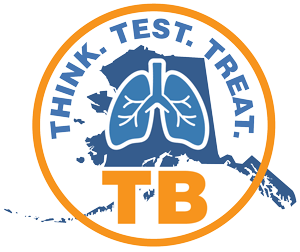Tuberculosis (TB)
Alaska's TB program helps prevent and treat this serious infectious disease
Overview
Tuberculosis (TB) is a serious infectious disease caused by bacteria. It is preventable and curable.
The Alaska TB Program is part of the Epidemiology Section, within the Division of Public Health. The goal of the Alaska TB Program is to end TB in Alaska.

Alaska TB Program
The Alaska TB Program:
- Provides medications for people with active TB disease
- Helps ensure that all people with TB infection or disease are on appropriate regimens
- Assists with the monitoring and case management of persons on therapy for TB infection or disease
- Helps identify persons exposed to TB
- Consults with providers, public health nurses, and the public
- Provides medication for people with active and latent TB
- Provides TB education and outreach to partners throughout the state
Alaska Has TB: Alaska has the highest rate of TB in the U.S. Anyone can get TB. Learn the facts and do your part to help end TB in Alaska
Also watch:
Local Heroes of TB: The Legacy of Tuberculosis in Southwestern Alaska
Symptoms & diagnosis
There are two types of TB, active and latent.
- Latent TB - People with latent TB do not have any symptoms and cannot spread TB. If they do not get treatment however, they may develop active TB in the future.
- Active TB - People with active TB do not always feel sick, but often have symptoms of TB. When someone has active TB they can spread TB to others.
TB primarily affects the lungs but can also impact other parts of the body.
Common symptoms include:
- Persistent cough (lasting more than three weeks)
- Coughing up blood or phlegm
- Chest pain
- Fever and night sweats
- Unexplained weight loss
- Fatigue
- Loss of appetite
Diagnosing TB may involve:
- Tuberculin Skin Test (TST): A small amount of TB protein is injected under the skin, and the reaction is checked after 48-72 hours
- Interferon-Gamma Release Assay (IGRA): A blood test that detects TB infection
- Chest X-ray or CT Scan: Helps identify lung abnormalities
- Sputum Test: Lab analysis of mucus coughed up from the lungs to detect active TB bacteria
Treatment
TB is treated with a combination of antibiotics over several months to ensure all bacteria are eliminated.
Prevention
- Early Detection & Treatment: Prompt treatment of latent TB can prevent it from becoming active.
- Infection Control Measures:
- Wear a mask if you have active TB
- Cover your mouth when coughing or sneezing
- Ensure proper ventilation in living spaces
- Testing for High-Risk Individuals: Regular TB screenings are recommended for health care workers, people with weakened immune systems, and those in close contact with TB patients.
- Vaccination: The Bacille Calmette-Guérin (BCG) vaccine is used in some countries but is not widely recommended in the U.S.
Reporting
Health care providers and laboratories are required to report tuberculosis within two working days.
Report a Health Condition Epidemiology Conditions Reportable to Public Health in Alaska: Statutes and Regulations Confidential Infectious Disease Report Form